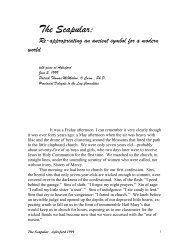Christocentrism of Charism – Buggert - CarmelStream
Christocentrism of Charism – Buggert - CarmelStream
Christocentrism of Charism – Buggert - CarmelStream
Create successful ePaper yourself
Turn your PDF publications into a flip-book with our unique Google optimized e-Paper software.
century Franciscan theologian, John Duns Scotus, on the question <strong>of</strong> the motive <strong>of</strong> the incarnation.<br />
For Scotus, sin or no sin, there would have been the Christ, for in Christ God was to bring his<br />
creation to completion. Hence, Rahner will view Christ from the perspective <strong>of</strong> creation itself, i.e. as<br />
its goal and culmination, or as DeChardin says, its omega point. In this regard, Rahner's is a "New<br />
Adam" or "Eschatological Adam" Christology, i.e. Jesus is the crown <strong>of</strong> God's creation itself.<br />
In this "New Adam" Christology, Christ will not be explained so much "from above" as<br />
"from below," or "from within," i.e. in terms <strong>of</strong> proceeding from creation itself, and in fact creation<br />
understood as occurring in an evolutionary way, i.e. in terms <strong>of</strong> the evolutionary, historical and<br />
creative process itself. In this way Christ will not appear as the big "exception," but as the supreme<br />
exemplification or the supreme instance <strong>of</strong> what God is always doing everywhere in God's creative<br />
activity. Hence Rahner's Christology can also be called an "archetypal" Christology. Jesus is<br />
"exhibit A" <strong>of</strong> the human, the perfect model, the New Adam.<br />
After taking the above mentioned Scotistic option, Rahner then contextualizes his<br />
Christology within the framework <strong>of</strong> evolution. He points out that as any being emerges from within<br />
the evolutionary process, it stops being "what it had been" and is now "sublated" to a new and higher<br />
level <strong>of</strong> being. When matter evolves to life, it is no longer mere matter but living matter. In other<br />
words, at every stage <strong>of</strong> the evolutionary process the new reality which emerges has a limited<br />
potentiality for development. It has limits to its possibilities <strong>of</strong> becoming. It can itself become so<br />
much and no more. If it transcends its own being in its process <strong>of</strong> becoming, an evolutionary critical<br />
threshold has been crossed and it ceases to be what it had been. When in the evolutionary process<br />
animal became human, it ceased being just an animal and has become rational animal. In simple<br />
language, you can teach a dog so many tricks and no more. Once the dog learns the trick <strong>of</strong> saying "I<br />
27



